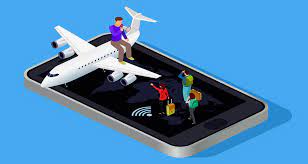- Have any questions?
- Office: +1 (650) 345-8510
- Mobile: +1 (650) 576-6916
- norm@traveltechnology.com
Business Travel Post-Covid 19, A New Reality

VR and AR Find New Relevance
April 16, 2020
Thoughts from the UK
April 22, 2020Business travel has halted, when it re-emerges, processes and procedures will change permanently.
It is official, business travel has come to a complete halt. The chaos caused by Covid-19 is a serious threat to all who make a living in the business travel industry. On April 20th, a NY Times article reinforced the fact “Business Travel Has Stopped. No One Knows When It Will Come Back.” Most would agree that business travel will return, but what will be the initial changes in business travel and when it does reemerge and what processes around planning and traveling will be permanently altered?
First a bit of background. The business travel market can be roughly divided into two large groups: managed and unmanaged. Unmanaged travelers, as the name implies, can make decisions based on their own personal needs and business objectives. The managed travel segment, also called corporate travel, is large and includes two dramatically different ends of the spectrum. Much of the market, is lightly or moderately managed which implies that company’s travel policy are guidelines, but that the traveler has the ultimate decision-making authority on which suppliers to chose or how to book their travel. On the other end of the spectrum are tightly managed businesses, generally the largest multinational corporations, who often have strict policies around which suppliers to choose and how travel should be booked.
The unmanaged travel market has slowly been penetrated by new “next-generation” travel management companies (TMCs) who have targeted the SME (Small Medium Enterprise) segment, thus often converting an unmanaged program to a lightly managed program. Considering the liability of the company incurs in respect to business travel, the trend to bring a level of control into the unmanaged segment seems a natural evolution that will accelerate as we begin to see business travel rebound. This will also include a greater emphasis on employee tracking and the need to implement a safety protocol in the event the traveler becomes ill during their trip. For those companies that continue to have unmanaged travelers, the decision to return to the skies will be predicated on the same criteria faced by all travelers, how can I ensure my health and safety while executing the goals of my trip.
Managed travel programs are likely to see the biggest changes as the industry recovers. Initially health and safety will be the top priority, but as volumes increase, employee tracking and support will have a new reinvigorated purpose. Many managed travel companies have used TMC/GDS data to track employee locations during emergencies. A significant number of corporate buyers have reported that their traveler tracking programs did not fulfill their needs during the Covid-19 shutdown as identifying precise locations of their travelers was difficult. Complicating this further is the large percentage, especially for hotels, of corporate travelers that book outside of the channel (not with the TMC or Online Booking Tool (OBT)). Unless a third-party tool is deployed to capture these out of channel bookings, the location of the travel is completely lost. Even with products such as Traxo that works in conjunction with a corporation’s email server and intercepts email confirmation from direct bookings, the process can be circumvented if the traveler used their personal email account. We are entering a new era of traveler mandated check-in programs. At least initially, expect that many companies will require their travelers to check-in daily even if this is implemented via text or email, to determine their exact location.
Beyond traveler tracking, a more permanent change in the way corporate travel is planned and authorized is likely to emerge. The use of pre-trip-authorizations have been around for decades and are primarily used today by large companies with strict policies and government or quasi- government (e.g. defense contractors) organizations. Much of the industry eliminated pre-trip authorizations as a simple “rubber stamps” that did not add value and often caused a delay in ticketing. The game has now changed. Pre-trip authorizations need to evolve to use a number of factors to allow a trip to occur. Beyond classifying trips based on the purpose, results of past trips need to be analyzed to measure their effectiveness. How often did the salesperson close the sale as a result of the trip? Did the customer visit help retain the customer?
Data drives business today, but little has been done to accurately measure the impact of each business trip. Now is the time for all stakeholders, corporate buyers, TMCs, OBTs, Expense Management System and corporate payment data providers to work closely with each other to analyze 2019 data to determine the effectiveness of each trip. This is not an easy task and would require cooperation and integration with internal systems such as Salesforce. At the end of the day, each company must understand the effectiveness of past travel by each employee in order to evaluate whether a future trip is warranted. Pre-trip authorizations will likely make a big comeback but driven by AI that helps determine if a trip will yield the desired results.
Of course, no one will start traveling for business again unless they feel safe, which only will occur with widely available testing and the ability to store and present the necessary medical documents. My previous blog talked about the role wearables may play in this process including measuring current traveler vital statistics. I will delve into other advances in Med Tech in a later blog post which will help make the transition to the new normal possible.
In preparation of a returning business travel industry now is the time for all the stakeholders to work together to not only evaluate the effectiveness of past trips, but use data which monitors the advance and decline of the virus, in order to match destinations that with travel patterns from previous robust years. Business travel is a key driver of economic growth but the new post-Covid 19 world will require every business trip to have measurable value.
Image courtesy of U.S. World News and Report

